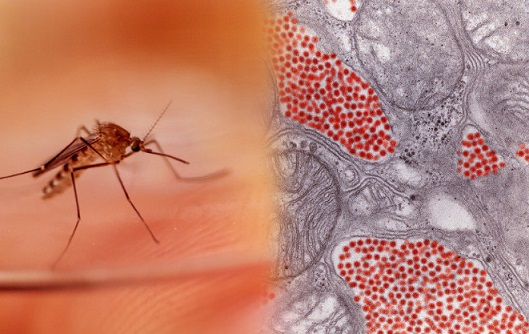Nikhil Prasad Fact checked by:Thailand Medical News Team Dec 15, 2024 3 months, 4 weeks, 20 hours, 18 minutes ago
Medical News: Eastern equine encephalitis virus (EEEV) is a rare but serious virus transmitted through mosquito bites. Its primary hosts are birds, but it can spread to humans and horses, leading to potentially fatal outcomes. The disease is caused by a virus of the Togaviridae family, genus Alphavirus, and poses significant public health challenges due to its neurological effects and unpredictable epidemiology.
 Eastern Equine Encephalitis Virus and Its Impact on Human Health
Eastern Equine Encephalitis Virus and Its Impact on Human Health
The EEE virus has an 11-kilobase genome encoding structural and non-structural proteins critical to its function and transmission. Mosquito species such as Culiseta melanura serve as the primary vectors, while bridging vectors like Coquillettidia perturbans help the virus spread to mammals. Despite being relatively rare, the virus is a major health concern due to its high fatality rate and severe clinical symptoms.
This
Medical News report delves into the findings of a recent study that highlights the roles of human metabolism and age in shaping the outcomes of EEEV infections. Researchers from the Department of Preclinical and Basic Sciences at Nicolaus Copernicus University in Poland and the Department of Cell Biology at Harvard Medical School-USA, collaborated to investigate the complex dynamics of this disease.
Key Study Findings on Transmission and Vulnerability
The EEEV has two distinct strains: enzootic and epidemic. The enzootic strain circulates between mosquitoes and birds, while the epidemic strain spills over into mammals. Geographically, the virus is most prevalent in the United States, particularly in the Atlantic and Gulf Coast states and parts of the Great Lakes region. Environmental factors like temperature, humidity, and rainfall significantly affect mosquito populations and virus transmission rates.
Research has shown that genetic factors in humans may influence susceptibility to EEEV. Specifically, mutations in the very low-density lipoprotein receptor (VLDLR), such as the W132G mutation, enhance the virus’s ability to attach to human cells. This insight opens avenues for targeted diagnostic strategies, particularly for organ transplant recipients and other immunocompromised individuals who are at heightened risk.
The Role of Metabolism and Aging in EEEV Outcomes
Human metabolism plays a pivotal role in viral infections, including EEEV. Viruses often hijack host metabolic processes to enhance their replication. The study revealed that EEEV disrupts mitochondrial function, which is crucial for energy production and immune responses. Mitochondria, known as the cell's powerhouses, are heavily impacted during infection, leading to impaired immune reactions and increased viral survival.
Aging further complicates the host’s ability to combat the virus. As people age, their immune systems undergo a process called immunosenescence, marked by diminished function and chronic inflammation. This phenomenon, known as inflammaging, makes older adults more susceptible to severe outcomes. Conversely, younger p
opulations, particularly children, also exhibit high vulnerability, possibly due to underdeveloped immune responses.
Clinical Manifestations and Diagnostic Challenges
The symptoms of EEEV infection can range from mild fever and headache to severe neurological conditions like encephalitis, seizures, and coma. The disease’s neuroinvasive nature leads to high morbidity and mortality rates. Diagnosing EEEV is particularly challenging because early symptoms are nonspecific and overlap with other viral illnesses. Advanced molecular tools, including RNA detection and serological tests for IgM antibodies, are essential for accurate diagnosis.
Treatment Limitations and Public Health Measures
Currently, there is no specific antiviral treatment for EEEV. Management primarily involves supportive care to address symptoms like seizures and respiratory distress. Experimental therapies, such as convalescent plasma, show promise but lack robust clinical evidence. Prevention remains the most effective strategy, emphasizing mosquito control measures and public education.
Vaccination efforts have seen some success in animals, particularly horses. However, no human vaccine is currently available. Research is ongoing to develop effective vaccines and antiviral agents, focusing on understanding the virus’s interaction with human metabolic pathways and immune responses.
Implications for Future Research
The study underscores the need for a multifaceted approach to combating EEEV. Screening for genetic mutations like W132G in high-risk populations could improve early detection and prevention strategies. Additionally, understanding the role of mitochondria in viral infections offers new therapeutic targets. By disrupting the virus’s ability to manipulate host metabolism, researchers may develop innovative treatments to mitigate its impact.
Conclusions
Eastern equine encephalitis virus represents a significant public health challenge due to its severe clinical manifestations and intricate epidemiology. The study highlights the interplay between human metabolism, immune responses, and age in determining infection outcomes. Effective vector control measures, public awareness campaigns, and advanced diagnostic tools are crucial in reducing the virus’s spread and impact.
Further research into the molecular mechanisms of EEEV and its interactions with host systems is essential for developing targeted interventions. With ongoing efforts to create vaccines and antiviral therapies, there is hope for mitigating the devastating effects of this disease. Public health agencies must prioritize surveillance and prevention strategies, particularly in endemic regions, to protect vulnerable populations.
The study findings were published in the peer-reviewed International Journal of Molecular Sciences.
https://www.mdpi.com/1422-0067/25/24/13318
For the latest on Eastern Equine Encephalitis Virus, keep on logging to Thailand
Medical News.
Interesting Reads:
https://wwwnc.cdc.gov/eid/article/27/7/21-0315_article
https://www.frontiersin.org/journals/tropical-diseases/articles/10.3389/fitd.2022.1077962/full
https://www.canada.ca/en/public-health/services/laboratory-biosafety-biosecurity/pathogen-safety-data-sheets-risk-assessment/eastern-equine-encephalitis.html
https://journals.asm.org/doi/10.1128/jvi.01586-09
https://www.cell.com/current-biology/pdf/S0960-9822(23)00679-6.pdf
Read Also:
https://www.thailandmedical.news/news/parts-of-massachusetts-america-goes-into-voluntary-lockdown-due-to-deadly-eastern-equine-encephalitis-virus
https://www.thailandmedical.news/news/breaking-medical-news-first-human-case-of-western-equine-encephalitis-in-20-years-reported-in-argentina-as-hundreds-of-horses-dying-across-the-country
https://www.thailandmedical.news/news/breaking-medical-news-crisis-unfolding-new-feline-canine-coronavirus-hybrid-sparks-global-concern-among-scientist-despite-attempted-coverups
https://www.thailandmedical.news/news/china-identifies-new-feline-coronavirus-that-is-extremely-lethal-and-could-pose-a-threat-to-humans
https://www.thailandmedical.news/news/outbreak-news-human-infection-of-h3n8-equine-avian-flu-reported-in-guangdong-province,-china
